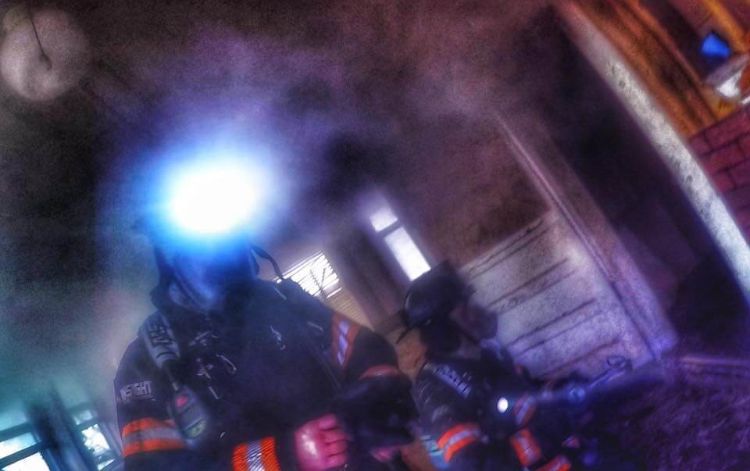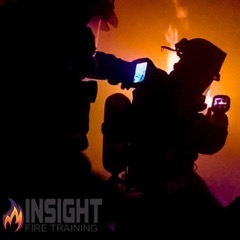Enhanced Search Methodology:
The use of thermal imaging cameras has enhanced the firefighter’s overall effectiveness particularly in the area of searching for victims or downed firefighters. In the late 90’s several large and well known fire departments were invited to participate in a study. They were given two identical search scenarios: one conducted without a TIC and one conducted with a TIC. The results were staggering. Without the use of a TIC the search crews missed the victims 60% of the time whereas they found the victim with the TIC while searching 99% of the time. In addition to this the total search time was greatly reduced (by up to 70%). And firefighters who used a TIC found their way out of the structure 100% of the time!

Our enhanced ability to conduct a search through the use of a TIC is an overall improvement but before we move forward into that we must discuss the dangers of over reliance on the use of a TIC while conducting a search.
Speed: As a well-trained thermal imaging camera user, we often have the tendency to move faster through a building. There are several reasons this can be hazardous:
First we must remember that the rest of our crew doesn’t have the luxury of seeing as clearly as the firefighter carrying the TIC. Therefore, if the crew leader is out in front and leads too quickly; their crew may become disoriented or lost especially if the crew leader isn’t following a hose line, a search rope, or following a specific search pattern (right hand wall search etc.).
The crew leader should scan the environment, communicate to their crew vital information and their directions and then move forward. Each movement should be a choreographed set of steps so that our crew is aware that the crew leader will scan, communicate, move, check crew integrity, reassess, and repeat the process.
Finding a victim in a fire environment with a TIC:
One of the problems with searching for a victim in a fire environment is the way that we were trained. Many of us have been trained to search for victims or firefighters in a fake or cold smoke environment or a dark room. This type of training is similar to an NFPA 1403 live burn; it’s valuable and informative but doesn’t truly expose the firefighter to the actual conditions in today’s fire environment. As we can see in the following video, the firefighters are searching in cold smoke (fake smoke) where it shows them and the victim as white hot.
The issue arises when we begin to search for the victim in the real fire environment. When under stress we always revert to our base level of training therefore if we are looking for a victim our last image in our minds is one of person that will show up as white in color on the TIC. This is because many of us were trained to search for victims when the victim was the hottest thing in the room. But now, we are in superheated environment looking for a 98.6 degree individual. Are you beginning to see the problem?
Now in the superheated fire environment the victim will most likely not appear as white but as black. The victim becomes one of the coldest objects in the room. This is why learning the specific color palettes that are mode dependent to your TIC of choice is essential. If a firefighter knows that the color scale is from cold to hot based upon this progression: black, gray, white, yellow, orange, red, and dark red then they will know that their perspective will be based on the temperature mode.
A victim can be hard to spot based on the focus and temperature mode of the TIC. The Crew leader should consider scanning low, medium, and high and letting the TIC adjust to the temperatures at each level and the associated temperature mode that will provide better clarity for the firefighter.
For example, if a crew is searching a 12×12 bedroom and the crew leader is directing their search with a TIC from the door way while staying oriented; the crew leader scans at low heights taking time to allow the TIC to adjust to the lower temperatures at the floor. This allows the camera to switch to a higher sense mode (a lower temperature range) which will show more details as we can see in the following rescue scenario of an adult victim with an infant victim lying underneath.
Most Thermal Imagers can take up to two seconds to adjust thus our scans should be slower while our searching efforts should be quick. The Crew Leader will also be looking for thermal cues on the floor such as signs of fire beneath their crew, radiative feedback on the flooring that may cause thermal insult to the crew. It is imperative that the crew leader stay low with their TIC as the cooler environment will allow the TIC to stay in the higher sensitivity temperature mode which provides better detail allowing them to see important objects or a possible victim.
The crew leader then scans again at medium height gaining valuable information such as egress points, room & furniture layout, and possible victim locations. The crew leader can then give the go signal for the search to begin.
The crew leader should scan the room high prior to their entry to check for thermal threat. The crew leader checks for superheated temperatures, signs of structural failure (such as exposed & deformed trusses).
A well trained crew leader will know the resolution of the TIC which also dictates the effective range of the TIC. This will cause a crew leader to stay within the optimal range to be truly effective (most often is between 7-20′). For example, if the area that is to be searched is outside of the optimal effective range of the TIC; the crew leader directs the search within the optimal effective range, picks a new point of orientation (and locates a secondary means of egress) and then directs the search within that next effective optimal range. This may be seen as meticulous but if we are searching for a victim our efforts should be almost surgically precise. Notice how quickly in the following video (the efficient portion) the crews are able to search THREE rooms with the direction and coordination of a trained tactical thermal imaging crew leader.
Understanding the importance of a resolution success chart could be the difference between making a save and missing one. When determining the effective resolution of a Thermal Imager it was based on the ability of the end user to identify a small child’s hand from a preset distance. This is important to note as when searching for victims we may only see one small part of their silhouette outlined in the thermal imager. As we can see in the following video, we compare a high resolution decision making TIC (A FLIR K53) vs a lower resolution situational awareness TIC (A FLIR K2) we can not clearly see the firefighter due to the lower resolution. Firefighters need to understand this before they search for a victim in a fire and that a scan of a room with a TIC does NOT replace a fundamental search! A TIC is NOT X-ray vision nor does it see everything.
Rapid Intervention:
In the event of a May-Day scenario, it is important to note that when searching for firefighters we will not typically find them in the same places as a victim nor will they present or be as easily identifiable in our thermal imaging display.
First, we must realize that any victim or firefighter will present on the thermal imaging display based on the overall temperature of the environment. For example, thermal imaging cameras display temperature differences or contrast that allows the end user to see the image. If we enter an incipient stage fire room and the room is around 100 degrees at the floor level a 98.6 degree body will not be easily identified. The crew leader could instruct the nozzle man to apply water to the ceiling or gas cool which will create a temperature difference thereby creating contrast allowing better visibility through the Thermal Imaging Camera.
Firefighters will often appear dark in superheated environments as they may be the coolest object in the room. Thus we should not only be concerned with heat signatures but cold spots (darker areas). We should be training ourselves to investigate the dark areas on our display and look for outlines such as helmets, boots, SCBA bottles. Also an SCBA bottle will often be the first object that is easily identified due to it will be the coldest object in the room.
Let’s summarize what we have learned today:
Crew Leaders shouldn’t move too fast due to overconfidence with the TIC. Their crew may become lost or disoriented resulting in a May-Day. Remember, they are not seeing what you are seeing! Practice this technique: Scan, communicate to our crew, move, check crew integrity, reassess, and repeat the process.
Pay attention to cold areas and shapes: Victims in a superheated environment will most likely be one of the coldest objects in the room. Therefore be on the lookout for dark objects and shapes that resemble body parts, firefighter equipment or gear such as SCBA bottles which will appear dark, and thermal latency which is a thermal footprint.
Superheated areas require an intentional scan of low, medium, and high areas allowing the Thermal Imaging Camera to adjust its sensitivity for better clarity to see the overall big picture.
Resolution matters! The ability for a Thermal Imaging Camera to discern small details at a set distance is based on its resolution. Firefighters must know and work within that range to truly be able to identify small details such as a child’s hand.
We offer training in this specific area that is offered between 8-16 hours with hands on training with our lead search instructor Thomas Anderson. If this information is useful to you and or you have found ways to improve or add to it please share your comments with me at:
Instructor Andy Starnes
andystarnes@instructorandystarnes.com

